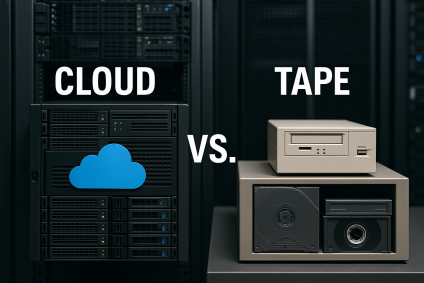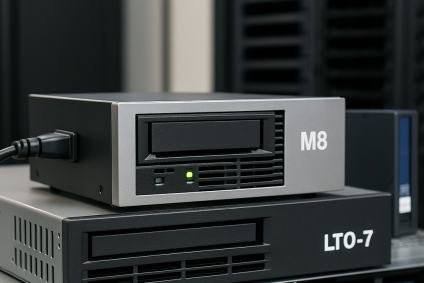Which Organizations Still Use Data Tape? Why Google, Amazon, Banks & NASA Still Trust LTO
Which Organizations Still Use Data Tape for Backup—And Why IT Leaders Should Care
For years, the tech world has tried to bury tape. “Tape is obsolete,” they say. “The cloud is the future.” Yet here we are in 2025—and some of the world’s largest corporations, financial institutions, government agencies, and even the biggest cloud providers still rely heavily on data tape for backup and archival storage.
Why? Because when it comes to long-term retention, cost efficiency, and ironclad security, tape quietly outperforms cloud and disk in ways many IT leaders don’t like to admit.
So, if the cloud giants themselves still use tape—shouldn’t your organization rethink how you handle cold storage, compliance data, and disaster recovery?
In this blog, we’ll answer:
- Which corporations are still using tape?
- Why do “future-facing” companies like Google and Amazon still trust 60-year-old tape technology?
- What are the risks of ignoring tape in your IT strategy?
- And how can IT Directors avoid making costly mistakes when it comes to backup media lifecycle management?
Q1: Do Big Tech Companies Really Still Use Tape?
Yes—Google, Amazon, Microsoft, and IBM all rely on tape. This revelation tends to shock IT leaders who assume hyperscale cloud means hyperscale disks. But behind the marketing slogans of “infinite cloud,” tape is the quiet backbone of their long-term archival systems.
Google: Tape in the Age of AI
Even the king of cloud, Google, uses Linear Tape-Open (LTO) technology to store petabytes of cold data. Google has openly acknowledged this strategy because:
- Cost Efficiency: Tape beats cloud economics at scale—especially for archival data rarely accessed.
- Energy Savings: Unlike spinning disks, tapes consume no energy at rest. That’s massive savings across Google’s data centers.
- Longevity: Properly stored, LTO tapes can last 30+ years, making them far more future-proof than HDDs or SSDs.
Controversial Take: If Google—who sells cloud storage for profit—still chooses tape for their own archives, doesn’t that undermine their entire “cloud-first” marketing pitch?
IT Directors, stop following the hype cycle. If Google can justify tape, you can too.
IBM: The Tape Giant That Never Left
IBM is both a producer and consumer of tape technology. Their IBM TS1160 and subsequent generations remain unmatched for enterprise-class archiving.
Why IBM still pushes tape:
- Data Integrity: Tape degradation is minimal, ensuring reliable retrieval decades later.
- Scalability: Tape libraries can expand faster and cheaper than disk arrays.
- Security: Tape’s air-gapped potential is a natural defense against ransomware.
Amazon (AWS): Glacier’s Hidden Tape Backbone
AWS markets S3 Glacier and Glacier Deep Archive as their cheapest storage tiers. What they don’t put on the billboard? Much of Glacier’s infrastructure is tape-driven.
- Low Cost: Glacier pricing is only possible because of tape’s economics.
- Scale: Amazon manages exabytes; tape handles that volume more gracefully than HDDs.
- Cold Backup for the Cloud: Yes, even cloud services need their own backups.
Controversial Take: Enterprises pay Amazon for tape storage they could manage in-house at a fraction of the cost.
Microsoft (Azure): Archive Storage and Tape’s Quiet Role
Azure Archive Storage works on a similar model to Glacier. While Microsoft doesn’t advertise it loudly, tape plays a crucial role in keeping archive-tier pricing so low.
- Disaster Recovery: Offline tape archives are invaluable when primary systems fail.
- Cost Control: Rarely accessed data belongs on tape, not expensive disks.
- Retention: Tape longevity aligns with compliance-driven storage mandates.
IT leaders—why rent tape from Microsoft when you can own the asset and retain more control?
Q2: Why Do Banks, Governments, and Media Companies Still Rely on Tape?
It’s not just Big Tech. Tape is deeply entrenched in finance, media, and government.
The Financial Sector: JPMorgan, Bank of America, and More
Banks generate staggering amounts of data and face strict compliance requirements mandating long-term retention.
- Compliance-Driven Storage: Tape is easily auditable and regulator-approved.
- Air-Gapped Security: Protects sensitive financial records from ransomware.
- Cost Efficiency: Billions of transactions archived at a fraction of the cost of disk.
If banks with trillion-dollar balance sheets still rely on tape, it’s not “old-fashioned”—it’s best practice.
Media & Entertainment: Disney, Warner Bros., and the Video Archiving Problem
A single 4K feature film can exceed 3 TB. Multiply that across raw footage, archives, and decades of assets—media giants would go broke if they used only disk or cloud.
- Scalability: Tape libraries can handle exabytes of media assets.
- Longevity: Movies need preservation for decades. Tape ensures continuity.
- Cost Management: Cheaper than cloud, essential for bottom-line profits.
Controversial Take: When Disney trusts tape to store its billion-dollar IP library, maybe it’s not “outdated tech” after all.
Government Agencies: NASA, NOAA, and National Archives
Government agencies manage some of the largest scientific datasets on Earth—satellite imagery, space exploration data, climate models.
- Data Preservation: Tape ensures critical datasets are safe for future generations.
- Cost-Effective Archival: Budgets demand low-cost, high-capacity storage.
- Security: Offline tape storage minimizes cyberattack risk.
If NASA entrusts tape with the future of space exploration, your IT department can trust it with compliance archives.
Q3: What Are the Hidden Risks of Ignoring Tape?
- Cost Overruns: Over-reliance on cloud means paying rent forever. Tape offers asset ownership.
- Ransomware Exposure: Without air-gapped tape, your backups are always vulnerable.
- Compliance Failures: Some regulators require physical, auditable records—tape fits that bill better than cloud snapshots.
- Vendor Lock-In: Big cloud wants you dependent. Tape gives you leverage.
IT Directors, rethink your tape strategy before your next audit—or your next ransomware attack.
Q4: How Should IT Directors Approach Tape in 2025?
- Run a Media Audit – Inventory old tapes, libraries, and drives. Many still have resale value.
- Leverage Buyback Programs – Retire old generations (LTO-6, LTO-7) and recover capital.
- Sanitize Securely – Ensure tapes are wiped or destroyed per NIST 800-88 to avoid compliance risk.
- Adopt Hybrid Strategy – Use tape for cold storage, cloud for active workloads, disk for performance.
- Don’t Get Locked Into Cloud Only – Maintain media independence to control costs.
At We Buy Used IT Equipment, we help enterprises audit, sanitize, and extract value from their legacy media and IT assets. Don’t let your tapes sit idle—or worse, become a compliance nightmare. Contact us today to start a tape buyback or secure destruction program.
Conclusion: Tape Isn’t Just Surviving—It’s Thriving
The myth of tape’s death is one of the biggest misconceptions in IT. From Google to NASA, from banks to movie studios, the evidence is clear: tape is still the foundation of long-term data strategy for the organizations that handle the most data on Earth.
So the question isn’t, “Why are these companies still using tape?”
The real question is, “Why isn’t yours?”
If you’re about to sell LTO or 3592 tapes, don’t make the same mistake thousands of companies make every year.
Before you sign anything, get a fair market valuation and secure destruction plan from us.
Go directly to the source. We have been providing secure data wipes and recycling storage media for over 60 years. We have been providing our services from the same company-owned location for over 30 years.
We pay the most and we pay fast.







